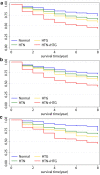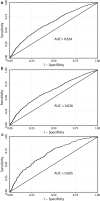Association of hypertension and hypertriglyceridemia on incident hyperuricemia: an 8-year prospective cohort study
- PMID: 33129322
- PMCID: PMC7603698
- DOI: 10.1186/s12967-020-02590-8
Association of hypertension and hypertriglyceridemia on incident hyperuricemia: an 8-year prospective cohort study
Abstract
Background: Hypertension and high triglyceride are two of the most important risk factors for hyperuricemia. Epidemiological records show that hypertension and dyslipidemia often coexist and may significantly increase the risk of target organ damage. However, their combined effect on incident hyperuricemia is poorly understood. Thus, we aimed to investigate the separate and combined effect of hypertension and hypertriglyceridemia on the incidence of hyperuricemia.
Methods: A prospective cohort study of 6424 hyperuricemia-free participants aged 20 to 94 years between August 2009 and October 2017 was performed at Tianjin General Hospital of China. Participants were categorized into four groups by combining hypertension and hypertriglyceridemia status at baseline. The restricted cubic spline fitting Cox regression model was used to evaluate the relationship between blood pressure and triglyceride and hyperuricemia. Cox regression models were performed to calculate hazard ratios (HRs) and 95% confident intervals (CIs) to estimate baseline factors and their association with the incidence of hyperuricemia. A Kaplan-Meier survival analysis was performed to compare the incidence of hyperuricemia among subjects in each separate and combined hypertension and hypertriglyceridemia group.
Results: During the 8-year follow-up period, 1259 subjects developed hyperuricemia (20.6%). There existed positive relationships between blood pressure and triglyceride levels and hyperuricemia. This risk factor arising from a combination of the two (HR, 3.02; 95% CI 2.60-3.50) is greater than that from hypertension (HR, 1.48; 95% CI 1.28-1.71) or hypertriglyceridemia (HR, 1.84; 95% CI 1.55-2.18) separately. The Kaplan-Meier survival analysis indicated that combined effect of hypertension and hypertriglyceridemia may predict higher onset of hyperuricemia.
Conclusion: The combined effect of hypertension and hypertriglyceridemia on the risk of hyperuricemia is much stronger than that by hypertension or hypertriglyceridemia separately. Hypertension combined with hypertriglyceridemia may be an independent and powerful predictor for hyperuricemia.
Keywords: Hypertension; Hypertriglyceridemia; Hyperuricemia; Prospective cohort study.
Conflict of interest statement
The authors declare that they have no competing interests.
Figures


Similar articles
-
Association between hyperuricemia and hypertension and the mediatory role of obesity: a large cohort study in China.Rev Assoc Med Bras (1992). 2023 Aug 21;69(8):e20220241. doi: 10.1590/1806-9282.20220241. eCollection 2023. Rev Assoc Med Bras (1992). 2023. PMID: 37610925 Free PMC article.
-
Dyslipidemia and hyperuricemia: a cross-sectional study of residents in Wuhu, China.BMC Endocr Disord. 2024 Jan 2;24(1):2. doi: 10.1186/s12902-023-01528-7. BMC Endocr Disord. 2024. PMID: 38166872 Free PMC article.
-
Impact of obesity and hypertriglyceridemia on gout development with or without hyperuricemia: a prospective study.Arthritis Care Res (Hoboken). 2013 Jan;65(1):133-40. doi: 10.1002/acr.21824. Arthritis Care Res (Hoboken). 2013. PMID: 22933424
-
Higher triglyceride level predicts hyperuricemia: A prospective study of 6-year follow-up.J Clin Lipidol. 2018 Jan-Feb;12(1):185-192. doi: 10.1016/j.jacl.2017.10.009. Epub 2017 Nov 7. J Clin Lipidol. 2018. PMID: 29137896
-
Association of serum uric acid and risk of hypertension in adults: a prospective study of Kailuan Corporation cohort.Clin Rheumatol. 2017 May;36(5):1103-1110. doi: 10.1007/s10067-017-3548-2. Epub 2017 Feb 7. Clin Rheumatol. 2017. PMID: 28176036
Cited by
-
Hyperuricaemia and its association with other risk factors for cardiovascular diseases: A population-based study.Endocrinol Diabetes Metab. 2022 Nov;5(6):e387. doi: 10.1002/edm2.387. Epub 2022 Oct 20. Endocrinol Diabetes Metab. 2022. PMID: 36266776 Free PMC article.
-
Independent and joint associations of body mass index, waist circumference, waist-height ratio and their changes with risks of hyperuricemia in middle-aged and older Chinese individuals: a population-based nationwide cohort study.Nutr Metab (Lond). 2021 Jun 13;18(1):62. doi: 10.1186/s12986-021-00590-z. Nutr Metab (Lond). 2021. PMID: 34120647 Free PMC article.
-
Sex-specific differences in the associations between adiposity indices and incident hyperuricemia among middle-aged and older adults: a nationwide longitudinal study.Front Endocrinol (Lausanne). 2024 Feb 9;15:1336471. doi: 10.3389/fendo.2024.1336471. eCollection 2024. Front Endocrinol (Lausanne). 2024. PMID: 38405154 Free PMC article.
-
Genetic risk of hyperuricemia in hypertensive patients associated with antihypertensive drug therapy: A longitudinal study.Clin Genet. 2022 Apr;101(4):411-420. doi: 10.1111/cge.14110. Epub 2022 Jan 24. Clin Genet. 2022. PMID: 35023146 Free PMC article.
-
A Cohort Study on the Correlation Between Serum Uric Acid Trajectory and New-Onset Hypertension Based on Longitudinal Health Examination Data in Henan Area.J Inflamm Res. 2024 Feb 27;17:1365-1375. doi: 10.2147/JIR.S446342. eCollection 2024. J Inflamm Res. 2024. PMID: 38439928 Free PMC article.
References
Publication types
MeSH terms
LinkOut - more resources
Full Text Sources
Medical

